Getafe, under José Bordalás, have risen as a team that has made the most out of the resources it has. Currently fifth in the table, the side is well on the way to securing a Champions League spot, sitting just a point short of third-placed Sevilla. Continuing the series of tactical analysis as La Liga‘s return date comes closer, this scout report will be based on Getafe’s analysis.
In this analysis, we’ll be looking at the weak aspects of Getafe’s tactics. We’ll be looking at how big teams have been able to edge past Getafe and what should be their concerns when the resume resumes.
Unvarying attacking style
Anyone that has watched Getafe play under Bordalás knows his style of ‘anti-football’. Getafe are intense while they’re pressing and have been effective with their strategy on most occasions. However, their approach of attack has been predictable and outclassed by major sides that they’ve faced so far.
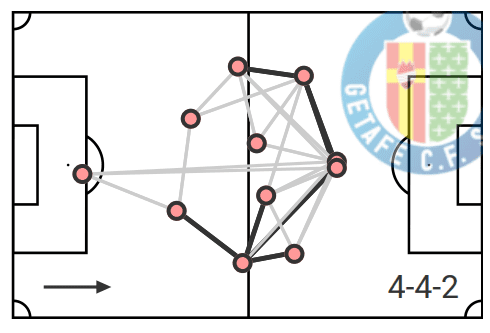
As we can see in Getafe’s average pass map this season, their connections happen through the wider side of the pitch. In general, Getafe prefer to play long balls, hit crosses, and score in the set-pieces. Lack of connection between the central midfielders can be seen clearly, with the wider players getting involved in the build-up. This also happens because central players frequently drift to support wider players in the press.
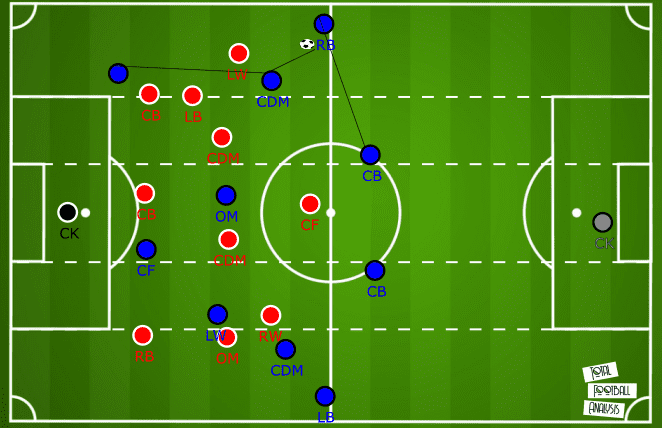
However, oppositions that overload the wider sides can counter these movements. Allan Nyom and Marc Cucurella, the wide players generally providing the channel between the backline and the forwards, are frequently outnumbered and are made vulnerable to frequent losses by big sides in La Liga.
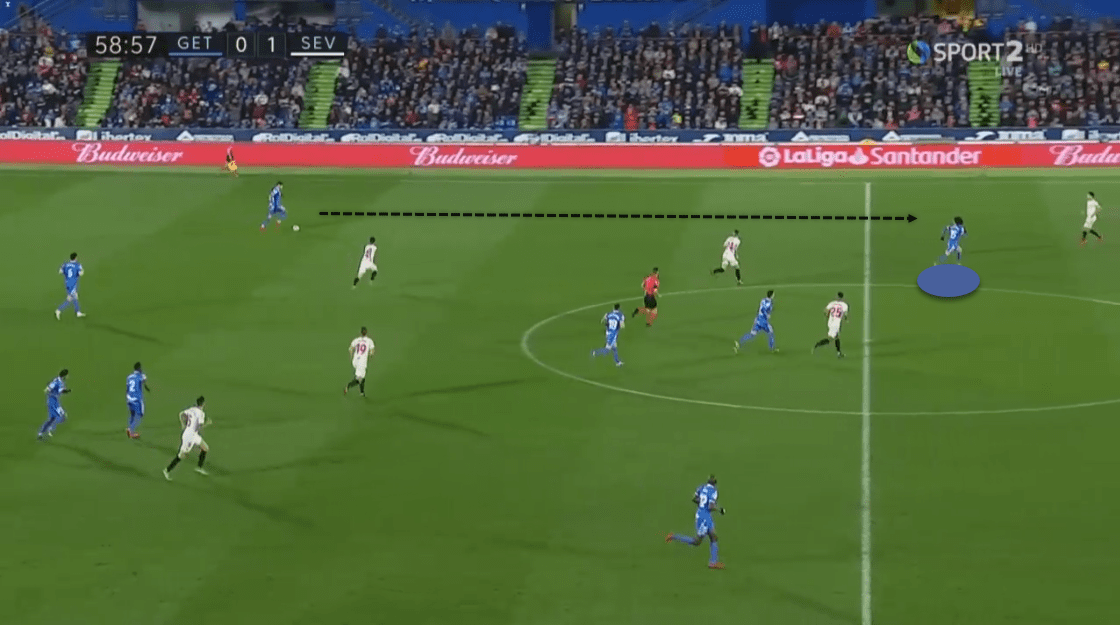
In this instance against Sevilla, a game that Getafe lost 3-0, we can see a classic demonstration of how wide overhaul and pass-delay works. Two Sevilla players are drifting away from the half-space in order to block the path of the anticipated wide pass. Similarly, a wide player is already in a good position to encounter run-making Cucurella. The pass is delayed by the two run-making players, whereas the wide player is in a position to go against Cucurella.
In addition, the other side of the pitch seems vacant due to the overhaul. However, due to the lack of players that can easily switch play and get the most out of unmarked players, Getafe rely on their traditional approach.
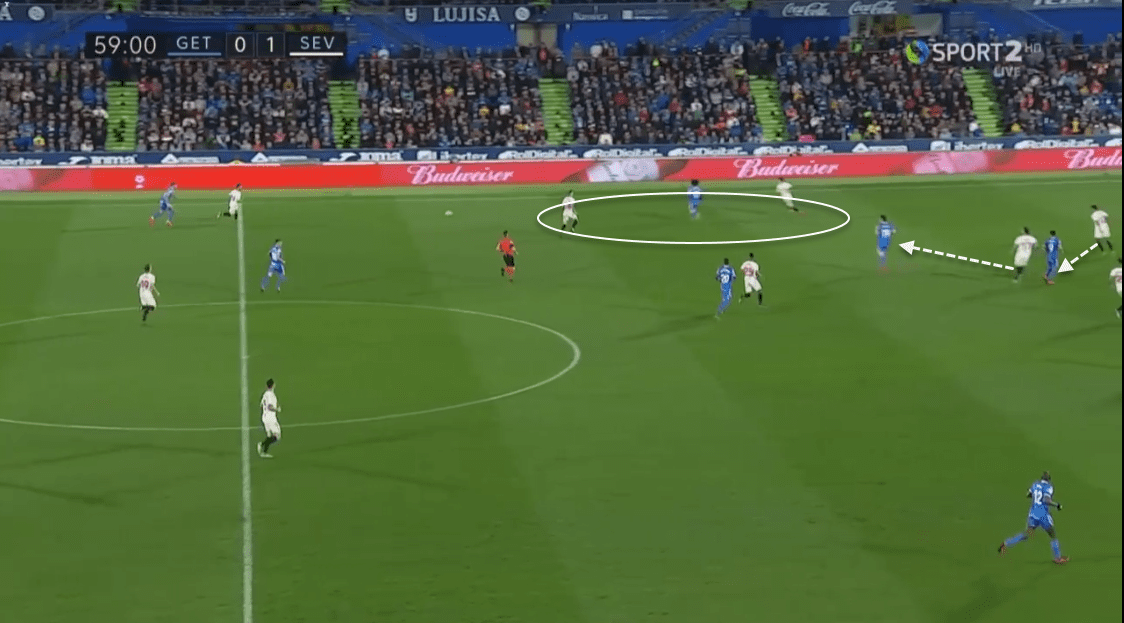
The delay works in this case and as we can see, Sevilla establish a 2v1 situation with the ball receiver. In this case, Sevilla have already set themselves up for winning the ball via Cucurella. The other players/ the probable passing chain is also well-covered, making it harder for Getafe to progress and create and attack.
Sides like Real Madrid, Barcelona, and Sevilla have been able to recover against Getafe using this approach. After winning the ball, the sides prefer to go via the central route, to exploit the space created by wide-drifting central midfielders, which we’ll talk about as the analysis progresses.
Positional lapses
Getafe tend to press higher up the pitch and establish numerical superiority to win back the ball. That is to say, every opposition that the Madrid-based side press, they try to establish chunks of 2v1 or 3v1 advantages. While this has been a very effective strategy in terms of winning back the ball, sides that are relatively good at resisting the press and find a passing channel have been able to overcome the positional shift on the press.
As the inverted wingers serve to help in the central area when Getafe are out of possession, spaces towards the wide flanks are frequently used by sides to build up. In this instance against Sevilla, Getafe are seen pressing the centre-backs, whereas the right flank is free for the build-up.
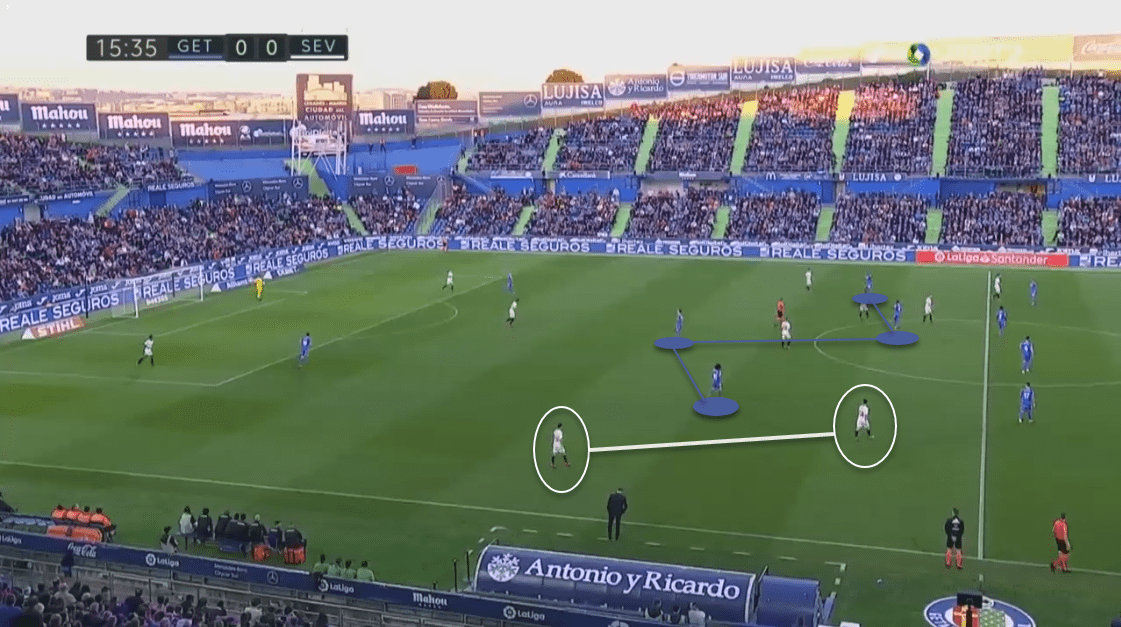
In this case, the goalkeeper always has the freedom to launch the ball wide. Since wider players are close to each other, they can always have at least one passing option between themselves. This free spot can be used to spot another man, or draw the Getafe press. Drawing the Getafe press will leave the other flank open and a switch in play can help to advance the ball from the other side.
Teams that are comfortable with long balls too can benefit from Getafe’s positional lapses. Teams can break lines using just a wide pass and penetrate into the Getafe defence. Although Getafe have been able to overcome this problem using their intense ball-winning manoeuvres, big teams with technical players always have an eye to capitalise on the occasion.
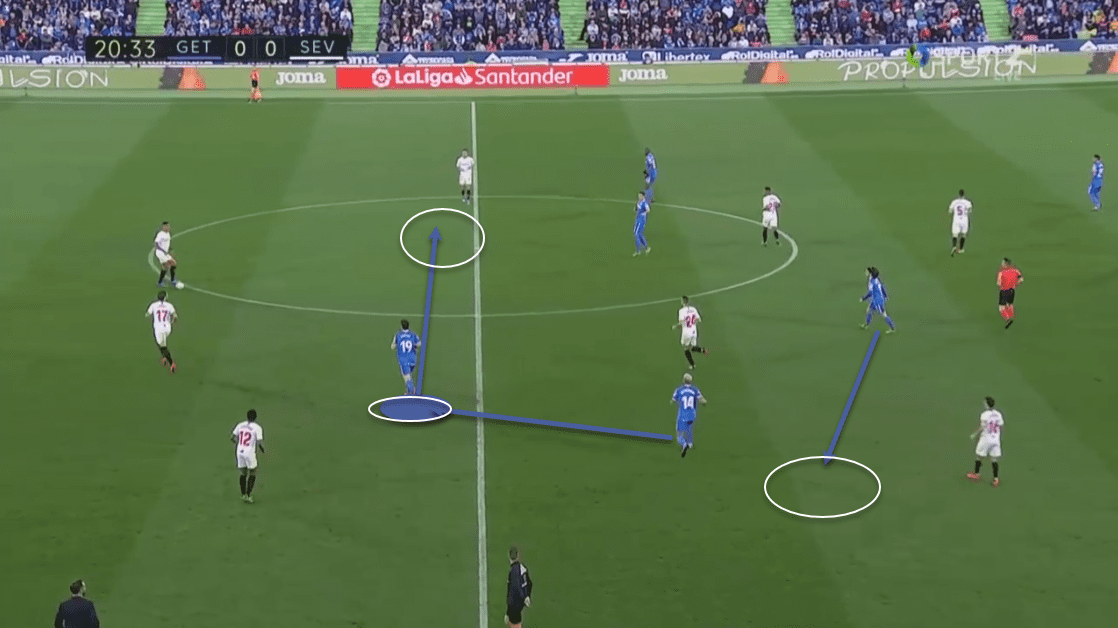
In this case, the opposition build-up looks to be directed towards the centre. In response, Marc Cucurella and Deyverson look to drift centrally, leaving their side unmarked. However, the centre back spots Jesus Navas, who is vacant because of the shift. Jorge Molina drifting towards the centre to cut-off the lane, Deyverson positioning himself on Molina’s original position and Cucurella’s return to his position can easily stop the build-up from the left and limit the central space. However, this doesn’t happen on this occasion and Getafe getting caught this way is frequent.
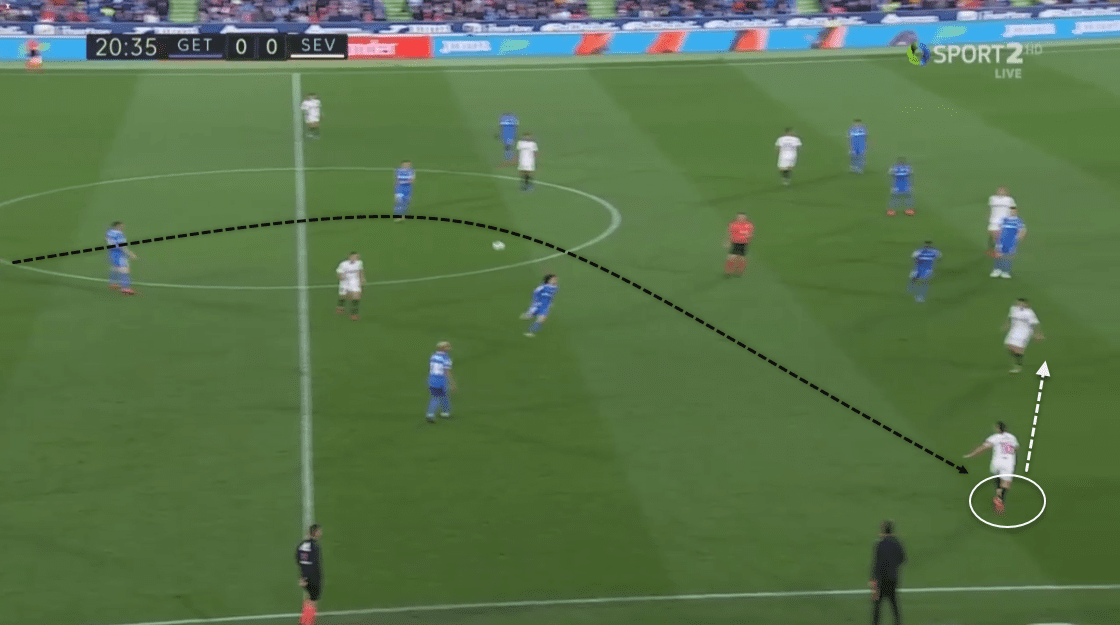
Eventually, the pass is played to Navas, who now has time and a close passing option to make the most out of the ball. Similarly, this leaves the pressing player in a disadvantage, as he has to cover the man quickly.
Getafe’s issues in position are prevalent higher up the pitch as well. Although Molina and Jamie Mata have been able to overcome the limitations, utilising each others’ strengths, Getafe often struggle to place themselves in good goalscoring positions. This can be explained by the fact that 12 out of 35 goals they’ve scored this season (33%) have come out of direct set-pieces or the moves after set-pieces. Only Ángel Rodríguez has been able to perform better than his xG of 6.81, scoring 10 goals. Similarly, like the rest of the players in the squad, Mata and Molina have underperformed significantly compared to their xGs.
In absence of an alternative route of working the ball inside the box, Getafe often have to rely on crosses to break low-block sides. Since Getafe’s forwards, excluding Rodríguez, are not excellent poachers, they have lesser quality goal-scoring chances. Nyom is the go-to man for Getafe in this case, as he is often seen going for the headers due to his physical abilities. However, lack of support always proves to be an issue during crosses, as seen in the instance below.
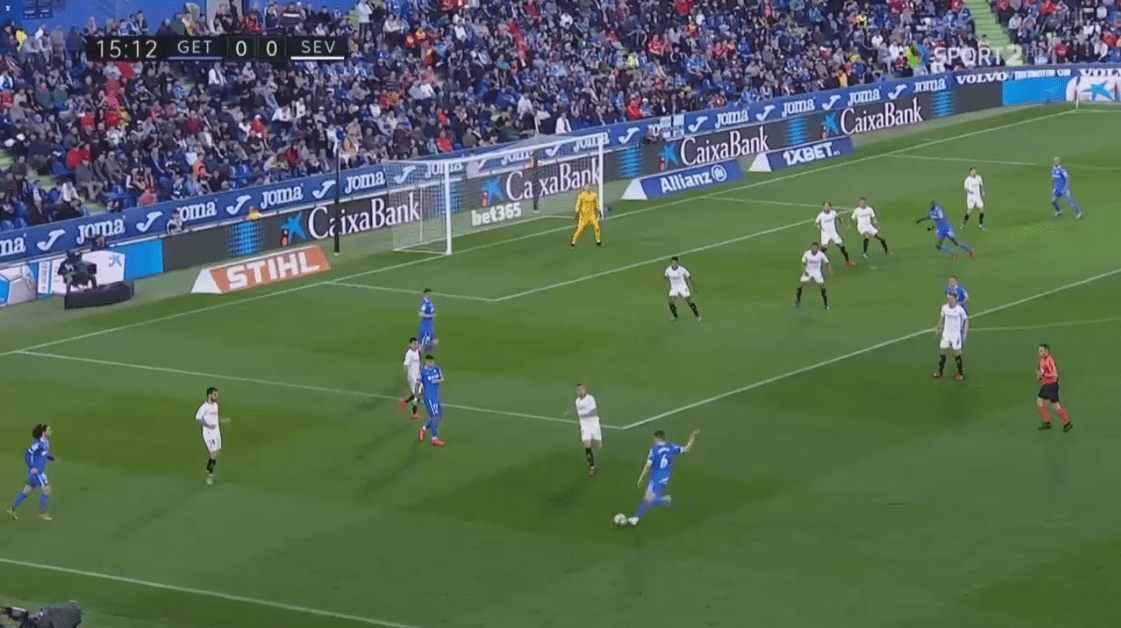
Getting caught from the centre
As we’ve already analysed, Getafe’s preference of advancing the ball from the wider side of the pitch is a usual sight. However, their failure to have players with the ability to hold on to the ball against immense opposition pressure makes them prone to attacks via the central void. The lack of a viable ball-player in the central midfield contributes to this problem, as sides have begun inviting wider presses against Getafe to open the central lane and exploit it.
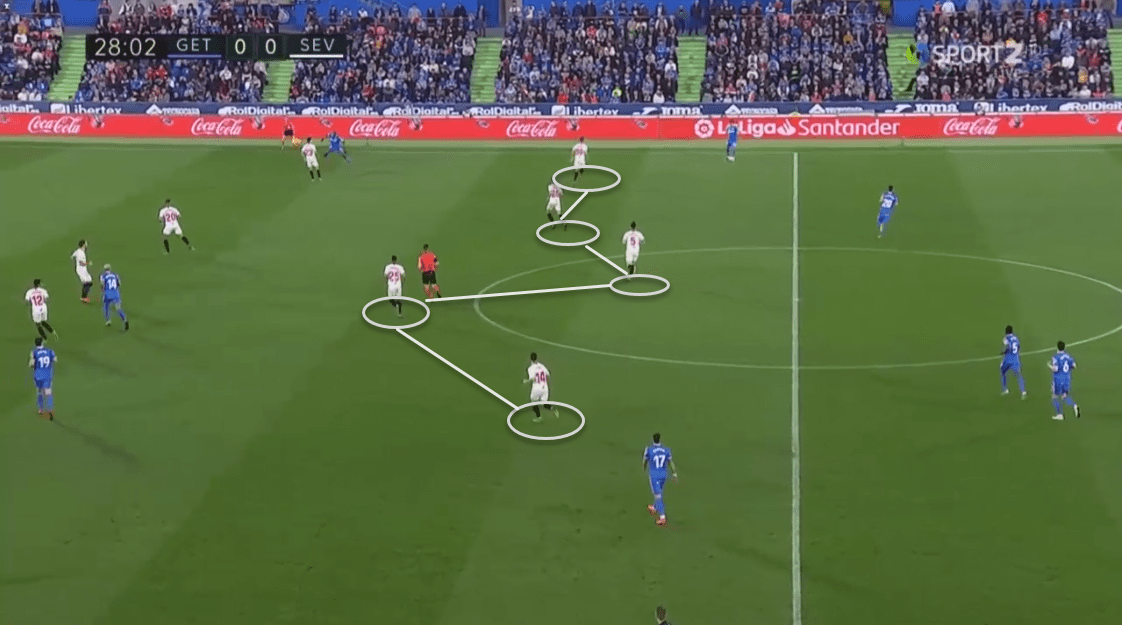
As we can see in the above structure, Getafe leave an array of opposition players to roam and control the centre of the pitch. The emphasis of playing from wide can backfire, especially if the opposition manages to win the ball and advance through the centre. This has happened multiple times in matches that Getafe have struggled in.
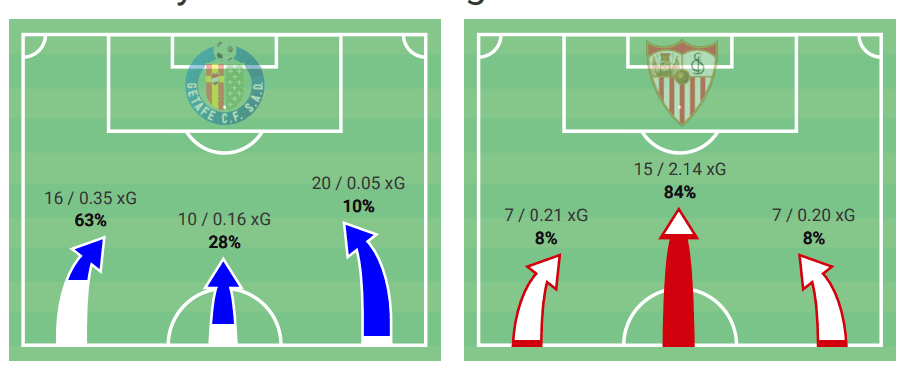
Looking at the attacks that Getafe faced against Sevilla, 84% of the total attacks have come from the central area of the pitch, with an astounding xG of 2.14. Teams with technical players in the middle can often repeat this feat against the present Getafe side.
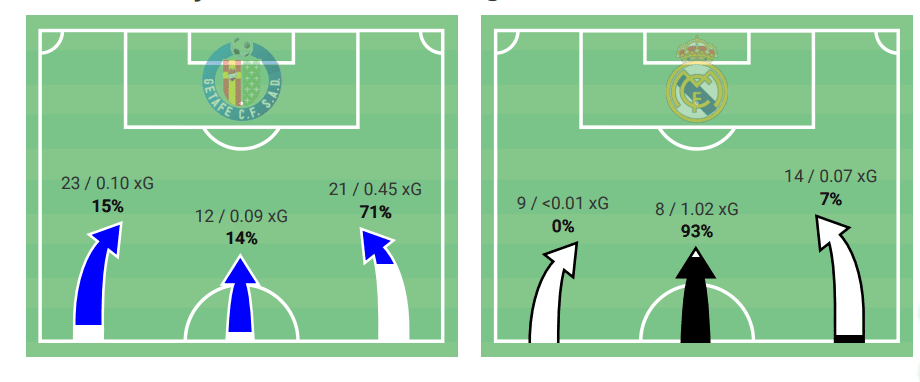
In the 3-0 loss against Madrid as well, 93% of Real Madrid’s quality attacks came from the central area of the pitch, effectively taking advantage of the wide drift of Getafe players. This is one of the main reasons why Getafe slipped to fifth despite occupying the third position at one point of the season.
This problem becomes more apparent in instances that Getafe tend to slow down and decrease their pressing intensity. When they’re not able to counter-press to win back the ball as soon as they lose it, their lack of central presence makes them suffer. In the fixture against Sevilla, Getafe conceded two goals during the period where they had the lowest PPDA, compared to the other periods of the match.
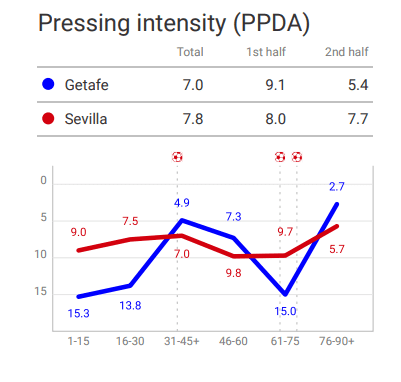
Similarly, this tendency to go all out on wider sides and limit the central presence haunts Getafe in transitions, as it leaves a void between the backline and the front line. As a result, teams target this area to cut off passes and win possession. Losses in this part of the pitch have proven to be costly for the Madrid-based side.
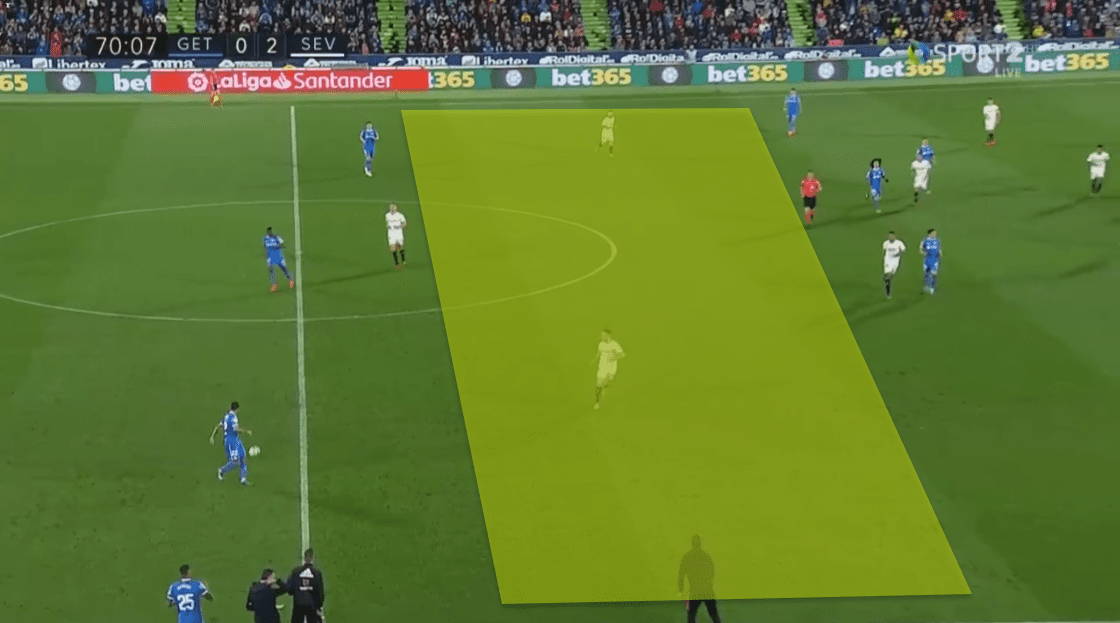
As they’re not able to transition properly, they allow the opposition midfield to control the tempo. While Getafe are able to deal with this most of the time with their intensity and physicality, sides that become dictative pose serious goal threats from the middle of the pitch.
Conclusion
Getafe have managed to impress everyone this season and look to be on the way to securing a Champions League spot. However, overcoming these weaknesses to shift focus into the tight schedule will be something Getafe will look to do.






Comments